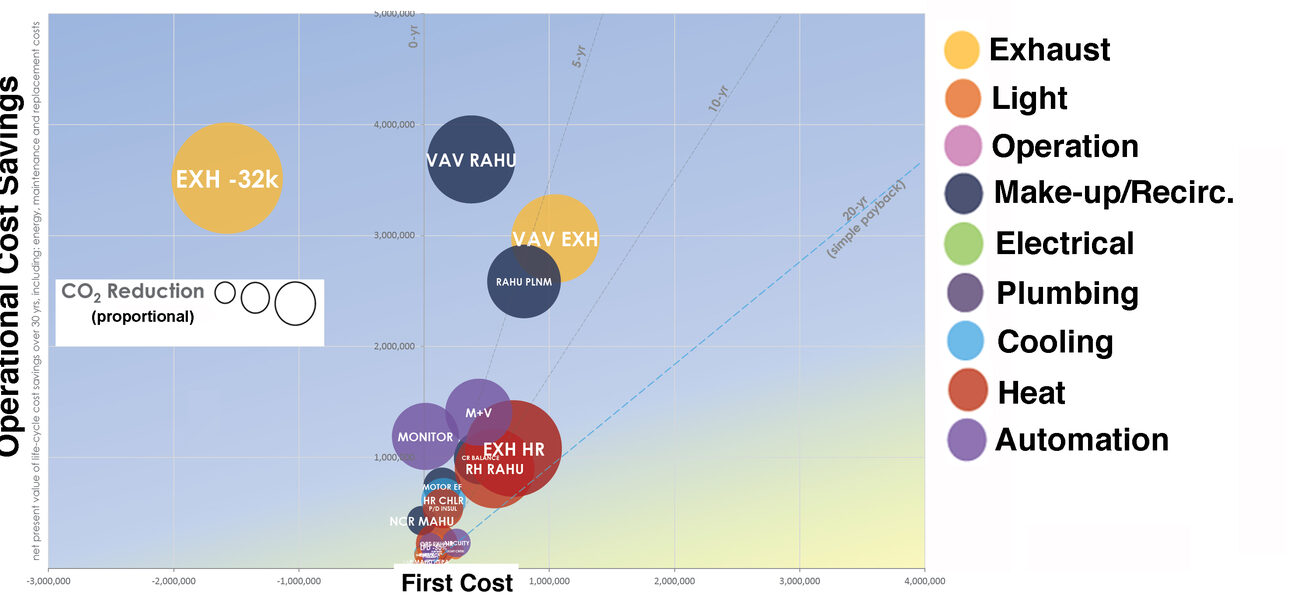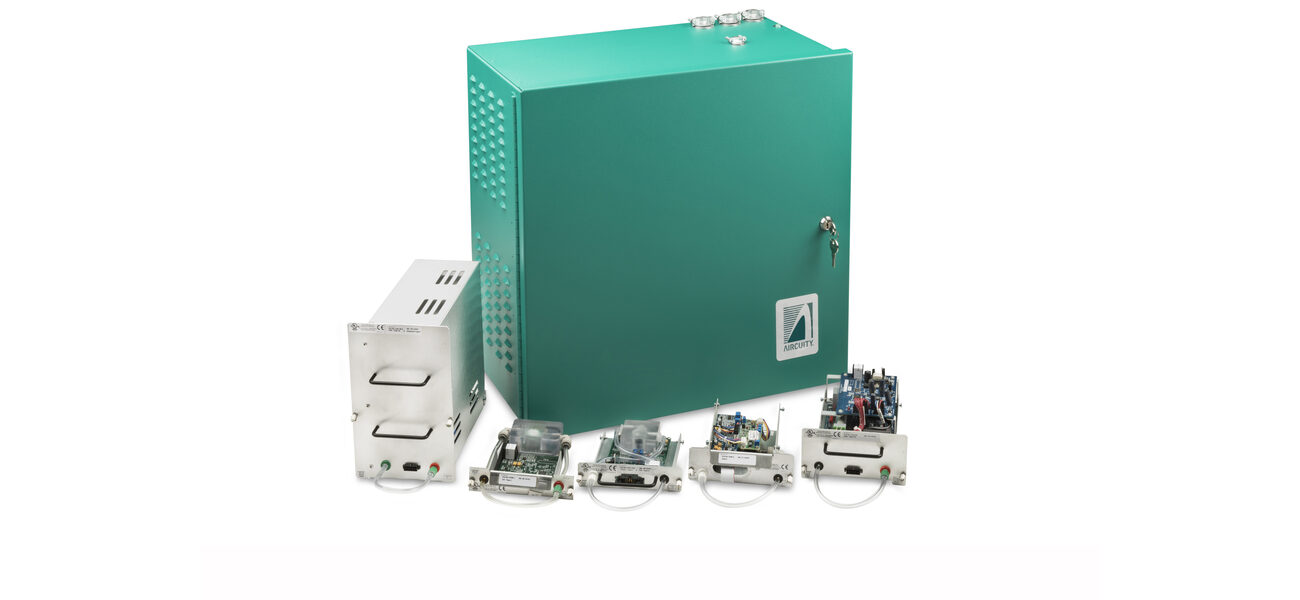Whether renovating an existing lab space or building a new one, conserving energy is likely to be a top priority—even more important than the return on investment. No longer a pie-in-the-sky goal, achieving net zero carbon in standard wet labs is now within reach with the right combination of measures, starting with ventilation management and moving toward electrification. Even cleanrooms, which are among the highest energy intensive laboratory types, could be next. MIT.nano, which opened in 2018 after seven years of planning and design, achieved best-in-class for energy performance, which the designers call “the first big step toward net zero” for these ultra-high-intensity facilities.
The Massachusetts Institute of Technology gave the designers and architects this challenge: Build a cleanroom research facility on a small piece of land, and make it the highest-performing cleanroom in the U.S.
“In the past, these buildings were not efficient. They were the opposite of efficient,” says Travis Wanat, senior project manager for capital projects at MIT, who worked with the team on the new facility.
Walt King, director of Thrive Building Solutions, (who was not involved in the MIT project), would agree. His specialty is working with organizations that want to get more energy efficiency out of existing lab buildings. By implementing technologies to optimize ventilation, he is usually able to improve a lab building’s efficiency by around 50 percent.
Both King and the MIT.nano team say they’re now seeing clients focus more on net zero carbon goals versus the more immediate ROI. “I’ve been around enough to see a pretty big culture change in how we talk about energy projects, from, ‘Is it a two-year payback?’ to, ‘How does it get us to net zero?’” says King. “That is a fundamental change in the way that our partner organizations are talking about these initiatives.”
Back up the Dump Truck
Fulfilling MIT’s requirements entailed a significant amount of planning to arrive at the right set of energy conservation measures—ideas that would make the building more efficient without canceling one another out or interfering with researchers’ work.
The team started with a list of every single conservation measure they could think of—140 in all.
“We backed up the dump truck,” says Jacob Knowles, director of sustainable design at BR+A, who were the design engineers on the project. “We’ve been working on projects for decades and we’ve got a pretty long list of ideas we can pull from. A lot of them are things we’ve thought about or implemented on past projects.”
The team then spent two years evaluating every one of those measures. “We calculated the energy cost savings, cost impact, maintenance cost, and lifecycle cost with net present value. We also calculated the carbon savings and whether it was base, above standard, or beyond standard,” says Knowles.
They also benchmarked 20 of the premier higher education cleanroom facilities across the country—including Harvard, Cornell, Duke, Georgia Tech, Princeton, Purdue, and UC Berkeley—using three major categories of metrics:
- Fresh air intake handlers (air changes per hour and dewpoint control)
- Recirculation air handlers (air changes per hour and efficiency of air movement)
- Tool load (watts per sf)
The team ultimately implemented more than 60 energy conservation measures, focusing on those that would deliver the best return on MIT’s investment. By combining this exhaustive analysis with the survey of the 20 higher ed cleanrooms, they identified eight “beyond standard” conservation measures that would result in significant energy savings, including heat recovery from sub-cooling to create free reheat, and a few different types of variable control systems to allow the building to optimize its operation. Of these eight strategies, MIT elected to implement six, exceeding all other peer facilities.
“We think this was a transformative project in the sense that we had to create a lot of the benchmarks that just weren’t there to begin with,” says Arlen Li, planning principal at HGA, the architects for MIT.nano.
Ventilation Management + Organizational Alignment are Key
The largest opportunity to improve energy efficiency in lab projects is usually in ventilation management. When Thrive Building Solutions is renovating existing labs, the first step is getting institutional alignment on ventilation. This requires C-level leadership and results in two key deliverables: a risk assessment framework driven by environmental health and safety, which defines lab air change rates based on exposure hazards; and an updated engineering standard incorporating key requirements for ventilation optimization. Once in place, these documents pave the way for portfolio-wide implementation.
King encourages an approach that engages important stakeholders, like an organization’s EH&S team. “Safety has to be front and center for all these initiatives,” he says. He cites a white paper on ventilation and sustainable laboratories, published in the magazine of the American Industrial Hygiene Association, that represents an evolution in the thinking in that field. “It’s a large shift in mentality. Rather than being defensive or maybe guarded about this topic, it is about how industrial hygienists can influence labs and have a positive impact on climate change.”
Pointing to a recent project at a Boston-based pharmaceutical company, King describes the measures Thrive took to safely optimize ventilation once institutional alignment was achieved:
- A lab-demand control system, with sensors to measure and adjust lab air quality in real time: When lab air is clean, the number of air exchanges per hour can be reduced; when a contaminant is present, the air exchanges swiftly ramp up to the maximum rate to clear out the unwanted substance.
- Fume hood controls to provide more efficient variable volume control of existing fume hoods, providing significant energy savings without having to replace large and costly hoods
- Exhaust fan control, using sensors or anemometers (instruments that measure wind speed) to lower fan speeds by more than 50 percent under safe conditions, only ramping to maximum capacity when necessary
In addition, the team working with Thrive was able to obtain utility company rebates for implementing conservation measures, money which went back into the capital expenditures budget. They then added ground-source heat pumps, new air handling units, and a new chiller.
“By doing ventilation optimization first, we were able to reduce the overall load in that building by about 30 percent,” says King. “What that means for their capex planning is that they have to solve to a smaller load. We have found that every dollar invested in ventilation optimization saves five dollars of capex needed to electrify buildings.”
At MIT, they were starting from scratch with new construction versus retrofit, so that team went to work on creating a space that was energy-efficient from the ground up. Like King, they started with ventilation. “The biggest energy consumer here was air movement,” says Wanat. Their chosen measures included exhaust heat recovery, variable air volume exhaust, 100 percent filter coverage in the cleanroom spaces, and demand-controlled air circulating units. Future benchmarks, to be implemented once the 216,000-sf building is full, will include managing the air flow rate and the dewpoint.
“These strategies are beyond normal practice in cleanrooms,” says Knowles. They installed a sub-cooling chiller to control the dewpoint, but full dewpoint management savings will depend on whether researchers find it beneficial. “It’s still up for debate as to whether relaxing that requirement will have any impact on the research. It’s up to the building operators to make that decision.”
“One of the things we were able to do in this space was to provide a fan deck—a giant open air plenum,” says Wanat. “That’s where we’ve made a lot of the changes in terms of volume and the ability to turn those systems down. We’re able to control those units and tie them to occupancy of the space while maintaining the clean classification of that space. The biggest contaminants in a cleanroom space are the people.”
They also covered the entire grid of the cleanroom ceilings with filters, to reduce the pressure differential and therefore fan energy, rather than alternating with blank panels as is often the case. Finally, they broke with tradition by adding both heating and cooling coils (instead of just cooling) to the recirculation units. The result is a space where sensors and technology are constantly modulating the air flow. “Overall, we achieved a 51 percent energy cost reduction compared to the baseline,” says Knowles.
Industry-wide Initiatives
Thrive’s playbook of energy reduction measures is based on the U.S. Department of Energy’s Better Buildings Initiative, which includes the University of California, Irvine. UCI’s Smart Labs initiative, first implemented in 2010, was in large part a ventilation management program, using sensors and software to optimize existing equipment.
The designers of MIT.nano—which achieved LEED Platinum certification and the AIA COTE (Committee on the Environment) Top 10 Award—are still innovating. One strategy is to tie a heat pump into the exhaust heat recovery system, to “basically supercharge the ability of that exhaust heat recovery system to pull heat out of the air and put it into the supply side,” says Li. “Amazingly, developers are now building these ultra-low and zero fossil fuel lab buildings, high rises all around the Boston area, using these types of technologies plus improved ground and air source heat pumps. So, we are upping the ante now, even on high performance projects like the one at MIT.”
Wanat is focusing on getting researchers at MIT to use the centralized facilities in the MIT.nano building instead of replicating functionality in a decentralized and inefficient way. The campus is also looking to continue pushing the envelope on energy conservation, while enjoying the savings achieved in the new cleanroom.
Despite the advances in the field, relatively few lab spaces have been designed or retrofitted for energy conservation historically. However, as the industry aligns around fully electric and net zero labs, ventilation optimization is a must-do, C-suite issue. “That’s what makes ventilation optimization really attractive,” says King. “It combines deep carbon savings, enables electrification, and provides a compelling NPV with significant operational savings.”
Li and Knowles believe even cleanrooms can be designed to be net zero.
“For this type of super-complex building, the biggest challenge is that first big step of getting best-in-class—defining that and achieving it,” says Knowles. “That’s your starting point. Most people think cleanrooms can never get to zero, because they don’t even know how to start. We’re showing them a path to at least make the first, most difficult step for that building type. We figured out how to get a clean room within striking distance of net zero.”
By Patricia Washburn

